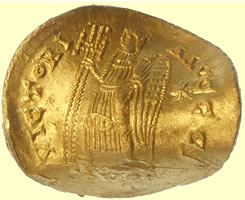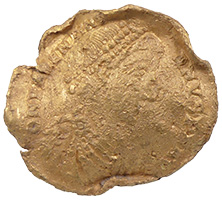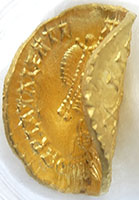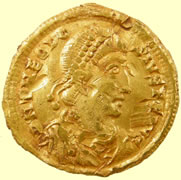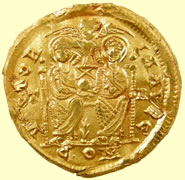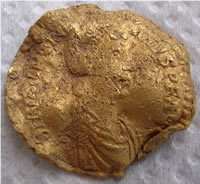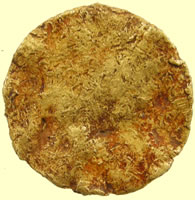

Metal detecting holidays in England with the World's most successful metal detecting club.20 years plus.
Twinned with Midwest Historical Research Society USA.
Roman gold coin finds
|
Gold and silver were an integral part of business and trade as far back as the early civilizations of Sumer (the land between the rivers Euphrates and Tigris in what is now Iraq) and Egypt. Solidus The
aureus was the main gold coin of the Early Empire, and its minting
was under the direct control of the Emperor. Under Augustus, the currency
was such: |
Roman gold coin 19mm,7.70g Well, even though Roman gold is way out of the orbit in which I normally travel, I see absolutely no reason to question its authenticity. I presume you know this is an aureus of Claudius. It’s obviously clear enough overall that there should be no doubt about the legends, but for the sake of form: My congratulations to all involved – well found! |
Roman gold coin - sent for ID 19.6mm, 7.81g Oh man, is that ever beautiful!
That is, of course, an Aureus of the emperor Claudius (41-54 AD) the presumed-to-be "simple-minded", somewhat disabled uncle of Caligula. He was seized upon by the Praetrorian guard as a tractible replacement after they had murdered Caligula, his wife and child. It turned out that Claudius was smarter than most of the Julio-Claudians and had merely allowed everyone to think he was simple-minded. This allowed him to hide in the background, out of the way of the endless palace intrigues. The successful ruse evidently kept him from suffering the sort of "mysterious" death which seemed to stalk all the other Julio-Claudians who might be in-line for or have some claim to being emperor. Once in power, he showed that far from being "simple", he was a shrewd and canny politician and proved to be a benificent ruler as well, righting a lot of the wrongs perpetrated by his evil nephew. Eventually, however, his love of women was his downfall. Marrying his neice, Agrippina Jr., the last of his succession of unfortunate marriages, he had inadvertantly adopted and brought into his home one of the true vipers in the Imperial nest, her son, the future emperor Nero. It is assumed that Agrippina, on her son's behalf, (or possibly even Nero himself) was responsible for feeding him a dish of deadly poisonous mushrooms. This removed the last impediment and cleared the way for Nero to become emperor.
This is one of the more common reverse types for Claudius' aureii, the PACI AVGVSTAE or "The Emperor's Peace". It has an interesting reverse type, too. Rather than Victory, whom you might assume was the winged character on the reverse, this is "Pax-Nemesis" performing a gesture associated with a uniquely Roman bit of superstition. She is drawing out a fold of her gown in what is called in some delicate circles an "Apotropaic gesture" - in other words, she's spitting on her own breast, which, like throwing a pinch of spilled salt over one's shoulder or touching wood, was a common superstitous custom among Romans and meant to deflect bad fortune.
This piece was struck in 41-42 AD at the imperial mint for precious metal coins, which happened at the time to be in the provincial capital at Lugdunum (modern Lyons) and coincidentally was also where the future emperor Claudius had been born.
This is actually one of the more common types of early Roman Imperial Aureii, but "common" here is all relative - particuarly in recent months, Roman Aureii have been bringing astonishing amounts of money - I wouldn't even venture a guess as to what the current market value of this piece might be - most likely at least in the 5-figures range of GBP's, Euros or Dollars.
Mark
|
5thC Roman gold sent for ID- my quick guess below Anastasius AV Solidus. 491-518 AD. 4.41 g. Constantinople. DN ANASTA-SIVS PP AVG, helmeted and cuirassed bust three-quarter face to right, holding spear over right shoulder and shield on left arm / VICTORI-A AVGGG and officina letter, Victory standing left, holding long jewelled cross, star to right (rarely: a cross). Mintmark CONOB. Sear Byz. 3; DO 3-5; MIB 3-5. |
|||
5thC Roman gold ID'd by Mark Lehman Very cool! I’m always impressed by the gold you folks find – it looks like it won’t be too terribly hard a job to straighten it out. 4.51g, 19.5mm
4.4g, 20.6mm Great Find! I figured out what I had missed first time around:
This is actually Valentinian II, 375-392 The piece is from, or copies types from the mint at Trier, as I presumed. Struck 389-391 AD The T - R in the reverse field is the mint mark - the exergual letters are "COM" RIC IX 90a; Depeyrot p. 124, 53/1 SRCV 20177 I'm still a bit concerned about the deposits - as I said, pure gold (900 fine or higher fineness) typically comes out of the ground just about completely clean, gold is non-reactive. Accumulated deposits are a result of free ions in the combinable elements of the alloy (typically copper in coin gold) reacting with whatever the coin is in contact with. The accumulation is, therefore, the result of a chemical reaction. That's why accumulated deposits are sometimes so hard to clean, - and occasionally easy - it all depends on what sort of chemical reactions produced the accumulated deposits. These reactions are enabled by the ph and other soil chemistry and the amount of moisture in the find site. As you certainly know, the deposits on dug coins can be anywhere from soft and friable to harder than concrete - it's all about the inhumation conditions. The deposits on this piece seem to be about what you might see on a piece of debased gold, maybe ~500 or less fine. I don't think it's a forrèe - we'd likely see core exposures, particularly with all the bending and denting, if it were not solid in its characteristics. Still, it's a major find even if it turns out not to be a strictly officially minted product. Mark
5thC Roman gold coin - 4.36g, 21.03m - sent for ID Constantine looking bust facing right I’m going to need a while on this one. It does look like a solidus. Whether it technically falls within the “Roman” series or the “Byzantine” series I can’t tell at this point. Mark Valentinian III, 425-455 AD. |
|||
  |
|||
Tiberious
14 to 37 AD gold Aureus - tested as 97% ancient gold |
|||
388 AD Theodosius I gold solidus 4.40g, 20.26mm This is, as you later suspected, Theodosius I rather than Magnus Maximus. A solidus of "Mag Max" would be a great item to find - Kipling included him as a character in "Puck of Pook's Hill" with a vividly-drawn, if fairly historically inacurate portrait. He's a good bit scarcer, in general, than Theodosius I, but the coin we're looking at today carries an "R2" rating in RIC, so it's pretty scarce as well. This is a Solidus - the denomination introduced by Constantine the great which would continue to be struck with very little variation in weight or fineness for nearly another thousand years as it became the flagship coin of the Byzantine empire.
Your specimen was minted at Trier, between 388 and 392 A.D. The "COM" in the exergue refers to it being pure gold - the mint designation is the T - R to either side of the two characters on the reverse - who are meant to be 2 co-regnal emperors - the basic design goes back to the time of Valentinian I and Valens, but continued until, at this time, it was supposed to be Valentinian II and Theodosius I as the 2 senior Augusti, there was however (throughout the era) a 3rd and even, at times, a 4th emperor.
The obverse legend is D N THEODOSIVS P F AVG - with the normal diademed draped and cuirassed bust right.
The reverse is VICTORIA AVGG (the 2 "G's" abbreviating "Augustorum" referring to multiple emperors) and shows the 2 emperors, presumably Valentinian II and Theodosius I seated facing, holding a globe between them, the top half of Victory between and spreading her wings above them.
RIC IX Trier 90b.
Congratulations to you and the digger - What a great find!
Mark
Roman Gold solidus of Valentinian I or II - Val I, 364-375 A.D. Val II, 375-392 A.D 4.42g 21mm dia Obv:
DN VALENTINIANVS PF AVG - would be the same for either.
Beat to death mid 4thC House of Constantine Roman gold coin 3.74g,21.23mm
Visigoths in Gaul, copying a coin of the Roman emperor Julius Nepos (AD 474-5) struck at Rome, 1.32g,14.1mm This is very interesting find, but unfortunately it is notAnglo-Saxon and neither is it a solidus. This is a semissis (half solidus) ofJulius Nepos (474-5), from the Rome mint (RIC X, 3207). The damage mayhave been caused by removal of a mount. Julius Nepos - Sure, he's one of the final "emperors" of the Western part of the Empire (huddled in Ravenna, waiting for the Gothic axe to fall) Julius Nepos had a first reign from 24 June 474 - 28 August 475. Then he fled and "enjoyed" a period of exile and a so-called "2nd reign" in exile in Dalmatia from September 475 - 9 May 480. His successor in Italy in 475-6 was the pathetic child-emperor Romulus "Augustulus", who returned the Imperial regalia to Constantinople in 476 - saying "I give up, this is impossible" or words to that effect. This moment is basically the end of the Western Roman Empire - except in the minds of all the barbarians who believed themselves to be the emperors continuing Roman "civilization" as Europe fell into feudalism. This is a "Tremissis", or one third of a Solidus. It appears to be from the mint at either Rome or Ravenna - it's only possible to tell the difference between the Rome, Ravenna and Milan issues of this type by the style and workmanship. It also appears to have been crudely broken off a soldered jewelry mount of some sort. I only checked it quickly in Sear. I will have a look in the RIC later, but RIC vol X is a beast of a book, both physically and to look up specific emperors and types - particularly in the chaotic final days of the Western Empire. "Cool beans!", however, as my kids would probably have said with they were teenagers - gold is always a great find! Mark Martin Allen forwarded details of this coin on to me which I have entered on our database: Unique ID: FASAM-310211 Object type certainty: Certain Gold tremissis, attributed to the Visigoths in Gaul, copying a coin of the Roman emperor Julius Nepos (AD 474-5) struck at Rome, dating to c. AD 475-500. Obverse: D N IVL NE - POS P F AVG; Pearl-diademed, draped and cuirassed right, with probable diadem above bust. Reverse: Staurogram in Wreath. Mintmark: COMOB. RIC X, p. 461, no. 3766var. RIC 3766 has a cross above the bust. Incomplete, possibly because a mount has been removed.
https://finds.org.uk/database/artefacts/record/id/710744 You will see I have re-identified the coin. I was wondering if you could provide me with a find-spot and finders name. With best wishes, Dr Sam Moorhead
|









